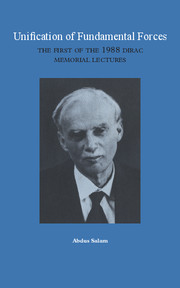Methods in theoretical physics
Published online by Cambridge University Press: 08 January 2010
Summary
I shall attempt to give you some idea of how a theoretical physicist works — how he sets about trying to get a better understanding of the laws of nature.
One can look back over the work that has been done in the past. In doing so one has the underlying hope at the back of one's mind that one may get some hints or learn some lessons that will be of value in dealing with present-day problems. The problems that we had to deal with in the past had fundamentally much in common with the presentday ones, and reviewing the successful methods of the past may give us some help for the present.
One can distinguish between two main procedures for a theoretical physicist. One of them is to work from the experimental basis. For this, one must keep in close touch with the experimental physicists. One reads about all the results they obtain and tries to fit them into a comprehensive and satisfying scheme.
The other procedure is to work from the mathematical basis. One examines and criticizes the existing theory. One tries to pin-point the faults in it and then tries to remove them. The difficulty here is to remove the faults without destroying the very great successes of the existing theory.
- Type
- Chapter
- Information
- Unification of Fundamental ForcesThe First 1988 Dirac Memorial Lecture, pp. 125 - 143Publisher: Cambridge University PressPrint publication year: 1990
- 1
- Cited by



